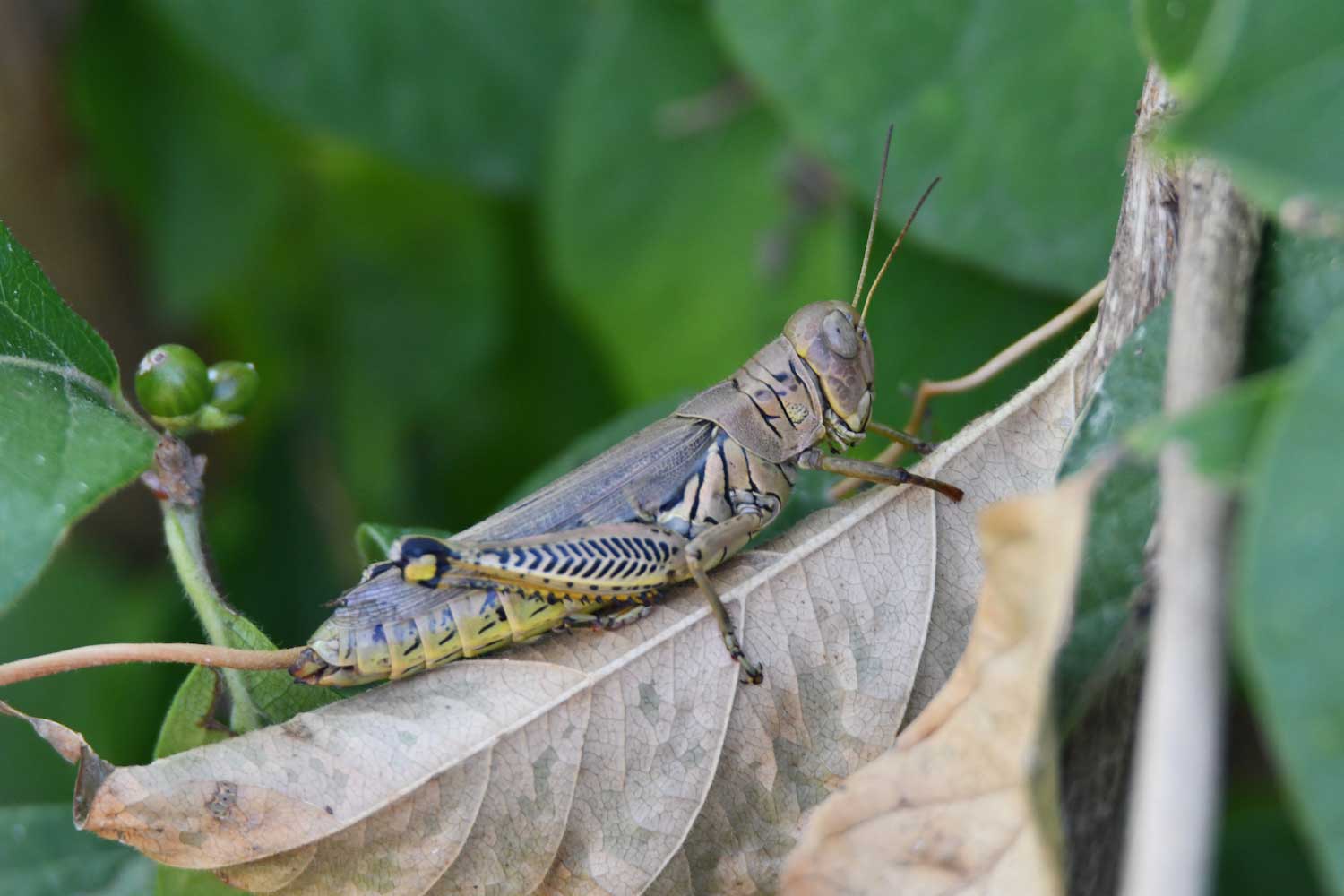Hop to it with these five grasshopper facts

Some of our most common insects remain silently unseen, but that's not the case with grasshoppers. The songs of male grasshoppers are part of the sounds of summer, plus grasshoppers have a habit of leaping up at us when we get too close for their comfort.
More than 10,000 species of grasshoppers exist in the world. Among the most common grasshopper species in Illinois are the admirable grasshopper, American bird grasshopper, Carolina grasshopper, differential grasshopper and longhorn band-wing grasshopper, according to the University of Illinois Extension.
They are a medium- or large-sized insect, growing to be between 1 inch and 7 inches long depending on the species. Females are usually larger than males. Grasshoppers are typically green, brown, gray or a combination of these colors to help them blend into their environment, according to the University of Michigan. They have large eyes and strong legs.
Read on to learn more about grasshoppers.
They can really hop to it
Have you ever been startled while walking through the grass and a grasshopper jumps up and out of your way? Their jumping ability is a pretty effective way of getting out of harm's way in a hurry, and luckily their back legs are built just for jumping. Grasshoppers can jump between 10 times and 20 times their body length.
Their ability to jump all comes from their back legs. They act like catapults, and when the grasshopper wants to jump, it contracts muscles in its hind legs and bends them at the knee then relaxes the muscles, according to Magnuson Children's Garden. A spring-like structure in the knee joint then releases all the energy, and off the grasshopper goes hopping into the air.
They know how to fly too
Thanks to their great jumping skills, we don't pay much notice to the fact that grasshoppers can fly too. In fact, they are actually strong flyers, according to Magnuson Children's Garden.
Flying is how grasshoppers escape predators and other dangers, the University of Michigan reports. Many creatures eat grasshoppers, including many other insects, spiders, birds, frogs, toads, snakes and lizards. To make a quick getaway, they first use their leaping skills to quickly get out of danger. Once airborne, they begin to fly.
Flying is also a means of finding food. Grasshoppers mostly eat plants, including leaves, stems, flowers and seeds, according to the University of Michigan. If they are in an area without a good supply of food, they can fly to a better location. They will even sometimes fly long distances in search of food, covering as much as 30 miles a day.
They make a lot of noise, but don't hear well themselves
Grasshoppers create sound by a process called stridulation, in which they rub one of their hind legs against one of their forewings. Their legs have pegs that create sound as they rub against the wing, according to the Magnuson Children's Garden. Each species of grasshopper has its own unique sound, which they use to attract a mate. In flight, they create another type of sound as their wings flap.
Despite their ability to make sound in different ways, they don't hear that well. Their "ears," which are simple auditory organs, are on their abdomens, tucked under their wings. With these organs they can ascertain different rhythms and intensities of sound, but they cannot hear the pitch.
They can cause massive destruction and famine
Have you heard the phrase "a plague of locusts"? Well, those locusts are grasshoppers. Locusts are a type of grasshopper, and what sets locusts apart from other grasshopper species is that they form massive swarms. These swarms can travel over land consuming all the crops and other vegetation in their wake, according to National Geographic. When this happens, entire regions can be devastated because a major food source is lost. This can cause widespread starvation and famine, particularly in Africa, where locusts are most destructive.
No locust species live in the United States, so the risk of these plagues of locusts does not exist here. However, more than 60 countries are at risk of locust swarms, mostly in Africa, Asia and the Middle East, National Geographic reports. A swarm of locusts can cover more than 460 square miles, and it can include between 40 million and 80 million of the insects. A large swam like that can consume 423 million pounds of vegetation in a single day.
In some parts of the world, they're a meal
It may not be common practice in the United States, but eating grasshoppers and other insects has been culinary custom for centuries in many parts of the world, National Geographic reports. In parts of Mexico and Central America, particularly the Oaxaca region of Mexico, grasshopper snacks called chapulines date back to the 16th century and are still commonly eaten today, according to the Institute of Culinary Education. Farmers rise early to catch the grasshoppers, then prepare them by roasting and frying them on a cast-iron griddle and seasoning them with chiles, garlic, lime and salt.
The people of Uganda, too, are known to snack on the crunchy bugs. In Uganda, grasshoppers are either boiled or deep-fried, and they are considered a delicacy in many communities, the BBC reports.
Insects are a regular part of the diet for more than 2 billion people in more than 80 countries worldwide, according to the U.S. Department of Agriculture. They have been an important food source for millennia, and researchers today believe they could be key to solving global food security issues as the world's population continues to increase. Insects like grasshoppers are seen as a desirable choice because they are high in protein and low in fat and also because the environmental impact of using them as a food source is minimal.
